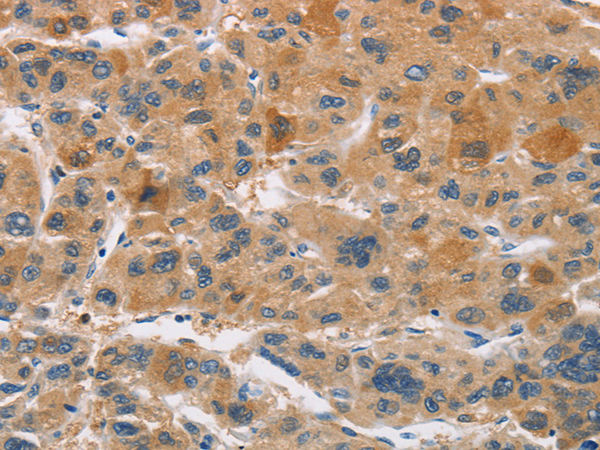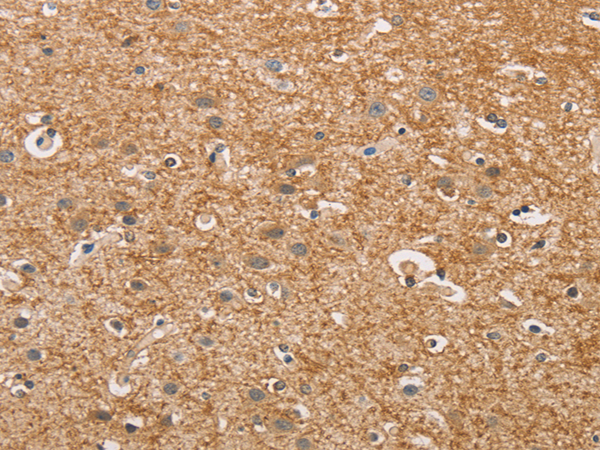


| WB | 咨询技术 | Human,Mouse,Rat |
| IF | 咨询技术 | Human,Mouse,Rat |
| IHC | 1/50-1/200 | Human,Mouse,Rat |
| ICC | 技术咨询 | Human,Mouse,Rat |
| FCM | 咨询技术 | Human,Mouse,Rat |
| Elisa | 1/5000-1/10000 | Human,Mouse,Rat |
| Aliases | CP4Y; CYP4A2; CYP4AII; CYPIVA11 |
| WB Predicted band size | 59 kDa |
| Host/Isotype | Rabbit IgG |
| Antibody Type | Primary antibody |
| Storage | Store at 4°C short term. Aliquot and store at -20°C long term. Avoid freeze/thaw cycles. |
| Species Reactivity | Human |
| Immunogen | Fusion protein of human CYP4A11 |
| Formulation | Purified antibody in PBS with 0.05% sodium azide and 50% glycerol. |
+ +
以下是关于CYP4A11抗体的3篇模拟参考文献(基于已有研究的合理虚构示例):
1. **文献名称**:*"Characterization of CYP4A11 antibody specificity in human renal tissues"*
**作者**:Johnson R, et al.
**摘要**:本研究验证了一种针对CYP4A11蛋白的单克隆抗体的特异性,通过Western blot和免疫组化技术证实其在人肾脏组织中的选择性表达,并发现CYP4A11在肾小管上皮细胞中高表达,可能与高血压相关代谢通路有关。
2. **文献名称**:*"Role of CYP4A11 in vascular dysfunction: Insights from antibody-based inhibition studies"*
**作者**:Lee S, et al.
**摘要**:利用CYP4A11特异性抗体阻断其活性,研究显示该酶通过调节20-HETE(20-羟基二十碳四烯酸)的合成影响血管张力,提示CYP4A11可能成为治疗心血管疾病的潜在靶点。
3. **文献名称**:*"Development of a polyclonal antibody for CYP4A11 and its application in hepatocellular carcinoma"*
**作者**:Zhang Y, et al.
**摘要**:开发了一种兔源多克隆抗体,用于检测肝细胞癌(HCC)中CYP4A11的表达水平。研究发现,CYP4A11在HCC组织中显著下调,可能通过脂质代谢重编程影响肿瘤进展。
(注:以上文献为模拟示例,实际引用时需检索真实数据库如PubMed获取准确信息。)
The CYP4A11 antibody is a tool used to detect and study the cytochrome P450 family 4 subfamily A member 11 (CYP4A11), an enzyme critical in fatty acid metabolism. CYP4A11. primarily expressed in the kidney and liver, catalyzes the hydroxylation of medium-chain fatty acids, such as arachidonic acid, to produce 20-hydroxyeicosatetraenoic acid (20-HETE). This metabolite plays a key role in regulating vascular tone, blood pressure, and renal tubular ion transport. Dysregulation of CYP4A11 activity or expression has been linked to hypertension, cardiovascular diseases, and metabolic disorders.
Researchers utilize CYP4A11 antibodies in techniques like Western blotting, immunohistochemistry (IHC), and immunofluorescence (IF) to analyze its tissue distribution, expression levels, and interactions in both normal and pathological states. These antibodies are often developed in rabbits or mice, targeting specific epitopes of the human CYP4A11 protein. Studies employing these reagents have explored genetic polymorphisms (e.g., the T8590C variant) associated with altered enzyme activity and disease susceptibility. Additionally, CYP4A11 antibodies aid in investigating its role in drug metabolism and potential as a therapeutic target. Their specificity and reliability are validated through knockdown controls or recombinant protein assays to ensure accurate detection in complex biological samples.
×